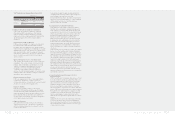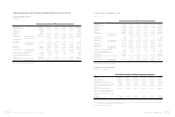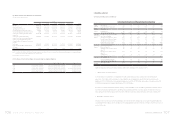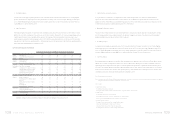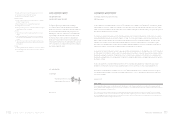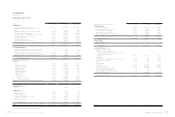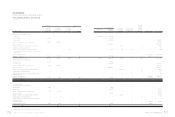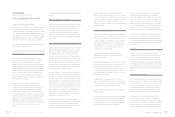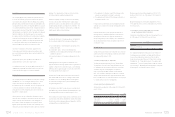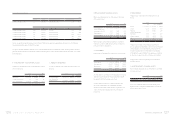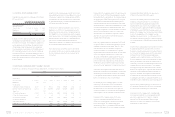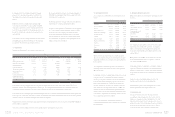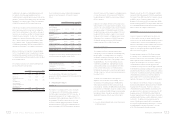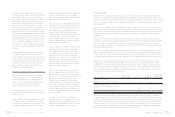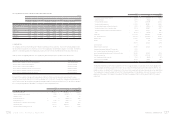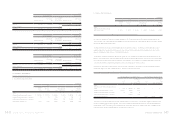HTC 2010 Annual Report Download - page 61
Download and view the complete annual report
Please find page 61 of the 2010 HTC annual report below. You can navigate through the pages in the report by either clicking on the pages listed below, or by using the keyword search tool below to find specific information within the annual report.
120 2 0 1 0 H T C A N N U A L R E P O R T 121
FINANCIAL INFORMATION
HTC CORPORATION
NOTES TO FINANCIAL STATEMENTS
YEARS ENDED DECEMBER 31, 2009 AND 2010
(In Thousands, Unless Stated Otherwise)
1. ORGANIZATION AND OPERATIONS
HTC Corporation (the “Company”) was incorporated on May
15, 1997 under the Company Law of the Republic of China to
design, manufacture and sell smart handheld devices. In 1998,
the Company had an initial public oering and, in March 2002,
the Company’s stock was listed on the Taiwan Stock Exchange.
On November 19, 2003, the Company started trading Global
Depositary Receipts on the Luxembourg Stock Exchange.
The Company had 7,284 and 10,843 employees as of December
31, 2009 and 2010, respectively.
2. SUMMARY OF SIGNIFICANT ACCOUNTING POLICIES
Basis of Presentation
The financial statements have been prepared in conformity
with the Guidelines Governing the Preparation of Financial
Reports by Securities Issuers, Business Accounting Law,
Guidelines Governing Business Accounting, and accounting
principles generally accepted in the Republic of China (ROC).
Under these guidelines, laws and principles, certain estimates
and assumptions have been used for the allowance for doubtful
accounts, allowance for loss on inventories, depreciation of
properties, income tax, royalty, pension cost, allowance for
product warranties, bonuses to employees, etc. Actual results
may dier from these estimates.
For readers’ convenience, the accompanying financial
statements have been translated into English from the
original Chinese version prepared and used in the ROC. If
inconsistencies arise between the English version and the
Chinese version or if dierences arise in the interpretations
between the two versions, the Chinese version of the financial
statements shall prevail. However, the accompanying financial
statements do not include the English translation of the
additional footnote disclosures that are not required under
ROC generally accepted accounting principles but are required
by the Securities and Futures Bureau for their oversight
purposes.
The Company’s significant accounting policies are summarized
as follows:
Current/Noncurrent Assets and Liabilities
Current assets include cash, cash equivalents, and those assets
held primarily for trading purposes or to be realized, sold or
consumed within one year from the balance sheet date. All
other assets such as properties and intangible assets are
classified as noncurrent. Current liabilities are obligations
incurred for trading purposes or to be settled within one year
from the balance sheet date. All other liabilities are classified
as noncurrent.
Financial Assets/Liabilities at Fair Value through Profit or Loss
Financial instruments classified as financial assets or financial
liabilities at fair value through profit or loss (“FVTPL”) include
financial assets or financial liabilities held for trading and
those designated as at FVTPL on initial recognition. The
Company recognizes a financial asset or a financial liability on
its balance sheet when the Company becomes a party to the
contractual provisions of the financial instrument. A financial
asset is derecognized when the Company has lost control of its
contractual rights over the financial asset. A financial liability
is derecognized when the obligation specified in the relevant
contract is discharged, cancelled or expired.
Financial instruments at FVTPL are initially measured at fair
value plus transaction costs that are directly attributable to the
acquisition. At each balance sheet date subsequent to initial
recognition, financial assets or financial liabilities at FVTPL are
remeasured at fair value, with changes in fair value recognized
directly in profit or loss in the year in which they arise. Cash
dividends received subsequently (including those received in
the year of investment) are recognized as income for the year.
On derecognition of a financial asset or a financial liability, the
dierence between its carrying amount and the sum of the
consideration received and receivable or consideration paid
and payable is recognized in profit or loss.
A derivative that does not meet the criteria for hedge
accounting is classified as a financial asset or a financial liability
held for trading. If the fair value of the derivative is positive,
the derivative is recognized as a financial asset; otherwise, the
derivative is recognized as a financial liability.
Fair values of financial assets and financial liabilities at the
balance sheet date are determined as follows: Publicly traded
stocks - at closing prices; open-end mutual funds - at net asset
values; bonds - at prices quoted by the Taiwan GreTai Securities
Market; and financial assets and financial liabilities without
quoted prices in an active market - at values determined using
valuation techniques.
Available-for-sale Financial Assets
Available-for-sale financial assets are initially measured at fair
value plus transaction costs that are directly attributable to the
acquisition. At each balance sheet date subsequent to initial
recognition, available-for-sale financial assets are remeasured
at fair value, with changes in fair value recognized in equity
until the financial assets are disposed of, at which time, the
cumulative gain or loss previously recognized in equity is
included in profit or loss for the year.
The recognition, derecognition and the fair value bases of
available-for-sale financial assets are similar with those of
financial assets at FVTPL.
Cash dividends are recognized on the stockholders’ resolutions,
except for dividends distributed from the pre-acquisition
profit, which are treated as a reduction of investment cost.
Stock dividends are not recognized as investment income
but are recorded as an increase in the number of shares. The
total number of shares subsequent to the increase is used for
recalculation of cost per share.
An impairment loss is recognized when there is objective
evidence that the financial asset is impaired. Any subsequent
decrease in impairment loss for an equity instrument classified
as available-for-sale is recognized directly in equity.
Revenue Recognition, Accounts Receivable and Allowance for
Doubtful Accounts
Revenue from sales of goods is recognized when the Company
has transferred to the buyer the significant risks and rewards
of ownership of the goods because the earnings process has
been completed and the economic benefits associated with
the transaction have been realized or are realizable.
Revenue is measured at the fair value of the consideration
received or receivable and represents amounts agreed
between the Company and the customers for goods sold in the
normal course of business, net of sales discounts and volume
rebates. For trade receivables due within one year from the
balance sheet date, as the nominal value of the consideration
to be received approximates its fair value and transactions are
frequent, fair value of the consideration is not determined by
discounting all future receipts using an imputed rate of interest.
An allowance for doubtful accounts is provided on the basis
of a review of the collectability of accounts receivable. The
Company assesses the probability of collections of accounts
receivable by examining the aging analysis of the outstanding
receivables and assessing the value of the collateral provided
by customers.
Inventories
Inventories consist of raw materials, supplies, finished
goods and work-in-process. Eective from January 1, 2008,
inventories are stated at the lower of cost or net realizable
value. Inventory write-downs are made item by item, except
where it may be appropriate to group similar or related items.
Net realizable value is the estimated selling price of inventories
less all estimated costs of completion and costs necessary to
make the sale. Cost is determined using the moving-average
method.
Held-to-maturity Financial Assets
Held-to-maturity financial assets are carried at amortized cost
using the eective interest method. Held-to-maturity financial
assets are initially measured at fair value plus transaction costs
that are directly attributable to the acquisition. Profit or loss
is recognized when the financial assets are derecognized,
impaired, or amortized. All regular way purchases or sales of
financial assets are accounted for using a trade date basis.
An impairment loss is recognized when there is objective
evidence that the investment is impaired. The impairment
loss is reversed if an increase in the investment’s recoverable
amount is due to an event which occurred after the impairment
loss was recognized; however, the adjusted carrying amount
of the investment may not exceed the carrying amount that


